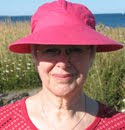I'm never totally positive when it's time to stop, and I confess, I always find it hard to let go. Plus I'm a slow painter. I like the easy pace of the contemplative process, the analysis, those adjustments, big and small, and I especially enjoy it when I can get into the bowels of a painting during its later stages. It's like reading a good book. I regret turning that last page, leaving behind a world that's given me so much pleasure.
Here are five images with accompanying descriptions describing some of my thinking at various stages during the making of this painting, and where it's led me. Keep in mind though that lots of time, thinking and painting has gone on between each stage.
1. In this version, a mid-point in the odyssey (check my last blog for the beginning images), the trees in the background are beginning to take shape. But I'm still struggling with how to make them distinct yet not overpower my main focus, the central character in my drama, that foreground tree. Should I make them darker, less distinct? How much detail should I include? They're the chorus, after all. They need to be heard, yet remain background voices. The color of the water and the sky is in flux here too. I've added a cloudy area, but I wonder, should the blue be lighter, darker, more robust?
2. The background trees are darker, closer in value left to right. I've also worked more on the filigree of branches that make up the foreground tree. I love those branches, one of the things that originally attracted me to this scene. I've also spent some more time developing the reflections in the water, and I've put a few more distinct clouds in the sky as well. The marsh grass still seems to be sitting well, so at this stage I've let that area be.
3. Still not entirely satisfied with those background trees, I reworked them yet again. This time I simplified the entire background area, editing out some of the separations between trees, and worked them as more structurally similar forms with larger masses of integrated foliage. Then I thought I'd try something new and maybe unexpected with the water. I changed the color, hoping to enhance the light by flipping that area towards a pale pink.
4. Well, turning the water pink didn't do much for me. So I changed it back to a light reflective blue to recapture the afternoon ambience. Staying with the water, I've also muted (and developed) the tree's reflections some more. The sky is now a lighter blue to mirror the color of the water. Generally more evenly darker in value, the background trees are also more of a cohesive group, and they seem more defined. Now the reorganized highlights in the trees reinforce the sense of the glancing late afternoon light I was looking for. On the whole, I've modulated, softened or emphasized the light throughout the painting.
5. This is the final version. Lots has happened between stages 4 and 5. For one thing, the foreground center tree has changed quite a bit. I reorganized and edited it, and in the process the tree's basic color morphed from being a predominantly burnt orange to a mellow yellow-green. I wanted to emphasize the tree's structure and energy, to make it lusher, fuller and more dynamic. The background trees were also repainted again, bringing them more into focus and lusher, while the marsh grass was softened into a mellower yellow. I also worked to develop the reflection of the tree in the water more distinctly, adding more color, ripples and transparency to the foliage so it would be more in keeping with the reconfigured tree above.
You can see a larger, more detailed image of this completed painting on my website.















